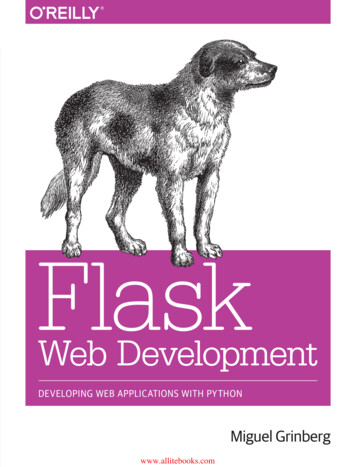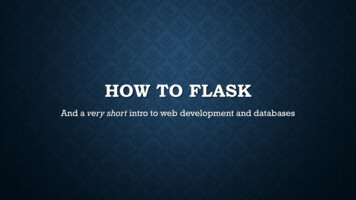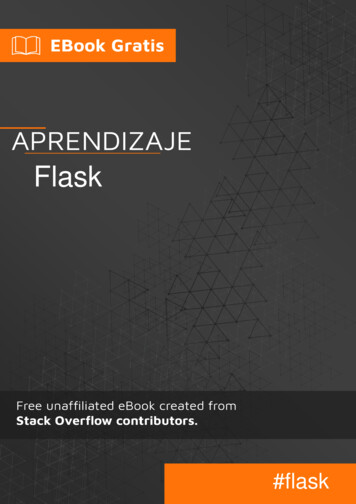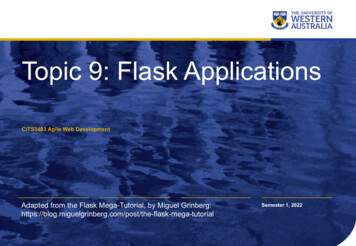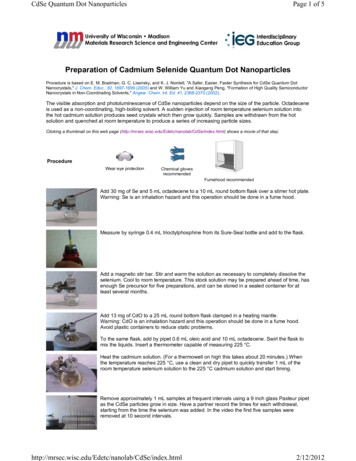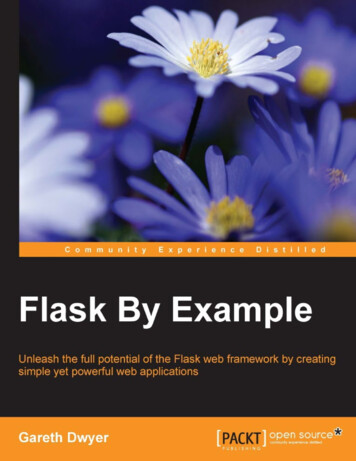
Transcription
Flask By ExampleUnleash the full potential of the Flask web frameworkby creating simple yet powerful web applicationsGareth DwyerBIRMINGHAM - MUMBAI
Flask By ExampleCopyright 2016 Packt PublishingAll rights reserved. No part of this book may be reproduced, stored in a retrievalsystem, or transmitted in any form or by any means, without the prior writtenpermission of the publisher, except in the case of brief quotations embedded incritical articles or reviews.Every effort has been made in the preparation of this book to ensure the accuracyof the information presented. However, the information contained in this book issold without warranty, either express or implied. Neither the author, nor PacktPublishing, and its dealers and distributors will be held liable for any damagescaused or alleged to be caused directly or indirectly by this book.Packt Publishing has endeavored to provide trademark information about all of thecompanies and products mentioned in this book by the appropriate use of capitals.However, Packt Publishing cannot guarantee the accuracy of this information.First published: March 2016Production reference: 1220316Published by Packt Publishing Ltd.Livery Place35 Livery StreetBirmingham B3 2PB, UK.ISBN 978-1-78528-693-3www.packtpub.com
CreditsAuthorGareth DwyerReviewersBurhan KhalidProject CoordinatorShweta H BirwatkarProofreaderSafis EditingKyle RouxRahul ShelkeCommissioning EditorJulian UrsellAcquisition EditorKevin ColacoContent Development EditorKajal ThaparTechnical EditorsKunal ChaudhariRavikiran PiseCopy EditorsShruti IyerSonia MathurIndexerRekha NairGraphicsDisha HariaProduction CoordinatorMelwyn D'saCover WorkMelwyn D'sa
About the AuthorGareth Dwyer first heard the phrase, "behind every no-entry sign there is a door,"a couple of decades ago, and he has been looking for a counterexample ever since.He hasn't found one yet. Gareth grew up with his three siblings in Grahamstown,South Africa. There wasn't much there except some highly respected schools anda small university. Gareth had heard that school was an unpleasant and largelypointless experience, so he opted to skip it and go to the university instead. Theuniversity door had a no-entry sign on the door because it only accepted people whohad gone to school. Gareth ignored the sign. He studied piano for a while but soon,he wondered if there was more to life than sitting in front of a keyboard all day. Sohe switched from piano to computer science, and it took him a while to realize theirony. He studied philosophy too because it was here that people never told him tostop being so argumentative.Gareth noticed the disparagement that his philosophy and computer sciencedepartments felt towards each other, and he found it strange. He soon discoveredthat he wasn't the first person to see that there was room for some common ground,and he went to Europe to study computational linguistics, where he found otherpeople who liked debating the finer points of language while talking about the threehardest problems of computer science (naming things, and off-by-one errors).In between doodling on blank paper while listening to very knowledgeable peoplelecture on content that was occasionally fascinating but often soporific, Garethhas gained so-called "industry" experience with companies such as Amazon WebServices in Cape Town and MWR InfoSecurity in Johannesburg. He has severalyears' experience in writing, and his favorite languages are English and Python.He discovered that writing and writing a book are not fully overlapping experiences,and the former is hardly preparation for the latter. The pages that follow would nothave come into existence without the combined efforts of many people.
AcknowledgementsThank you Neeshma and Kajal; you have been so very kind and patient in spite of mydisrespect for deadlines. Your feedback on each chapter while I was writing and yoursuggestions that I try to keep to schedule have been invaluable. Thank you to everyoneelse at Packt Publishing who has been involved in this book, from its idea, throughediting, through layout, through marketing, and all the nitty-gritty parts that thereader will never think about. I'm looking forward to the next one already.Thank you Alisa for listening, even when I complained about writing, and evenwhen I was still complaining a year later.Thank you Theresa, Stephanie, and Lewis for ensuring I don't go completely sane.Thank you to all the lecturers and tutors at Rhodes University who contributed towhat I know and who I am.Thank you Ron for teaching me how to string words together, and how commaswork, and why some sentences sound nice and others don't.Finally, thank you Mom and Dad for teaching me everything else.
About the ReviewersBurhan Khalid has always been tinkering with technology, from his early dayson the XT to writing JCL on the ISPF editor, and from C and C , Java, Pascal,and COBOL to his latest favorite, Python. As a lover of technology, he is mostcomfortable experimenting with the next big technology stack.By day, he works in a multinational bank in the Alternative Channels unit, where hegets to hack on, develop, and test applications that help execute transactions across allmanner of electronic devices and channels. In addition to his work, he also contributesto open source projects, having released a few toolkits for transaction processing, andhe offers consultancy services to startups on their technology stacks and developmentprocesses.He is an avid volunteer; he is a mentor for Sirdab Lab (a startup accelerator),a frequent speaker at the local Google Developer's Group, a presenter and volunteerat StartupQ8 (a startup community), and an active user on StackOverflow.You can reach him on Twitter @burhanI would like to thank my mother and father for always encouragingme, my wife for putting up with my long days at the keyboard andmy ever-growing gadget collection, and my friends and colleaguesfor providing me with new challenges to sharpen my skills.
Rahul Shelke is a cofounder of My Cute Office Pvt. Ltd. and Qpeka TechnologiesPvt. Ltd. He also acts as an adviser for two other startups, and he helps startups intheir growth.Prior to starting his own venture, Rahul worked with Blisstering solutions for morethan two years as a senior developer.He is an MTech in computer science. His practical experience for the last five yearshas been in web development, cloud computing, business intelligence, systemperformance optimization, and software architecture design and development.He has been actively involved in open source contributions since graduation,and he has contributed to Python, Python-Flask, and Drupal.First, I would like to thank the Packt Publishing team, Shweta H.Birwatkar, and Gareth Dwyer, for giving me the opportunity to be apart of this project.A special thanks to My Cute Office team whose support helped memanage work along with this book review. I would also like to thankmy family for supporting me during this process.Finally, thanks to the countless support from Python-Flask's opensource community for providing me with such an easy and fast webdevelopment framework.
www.PacktPub.comeBooks, discount offers, and moreDid you know that Packt offers eBook versions of every book published, with PDFand ePub files available? You can upgrade to the eBook version at www.PacktPub.com and as a print book customer, you are entitled to a discount on the eBook copy.Get in touch with us at customercare@packtpub.com for more details.At www.PacktPub.com, you can also read a collection of free technical articles, signup for a range of free newsletters and receive exclusive discounts and offers on Packtbooks and ion/packtlibDo you need instant solutions to your IT questions? PacktLib is Packt's online digitalbook library. Here, you can search, access, and read Packt's entire library of books.Why subscribe? Fully searchable across every book published by Packt Copy and paste, print, and bookmark content On demand and accessible via a web browser
To Ron Hall, who taught me how to write
Table of ContentsPrefaceChapter 1: Hello, World!ix1Introducing FlaskCreating our development environmentInstalling pipInstalling FlaskWriting "Hello, World!"Writing the codeRunning the codeDeploying our application to productionSetting up a Virtual Private ServerConfiguring our serverInstalling and using GitServing our Flask app with WSGI2223335668911Summary16Configuring Apache to serve our Flask applicationChapter 2: Getting Started with Our Headlines ProjectSetting up our project and a Git repositoryCreating a new Flask applicationIntroduction to RSS and RSS feedsUsing RSS from PythonURL routing in FlaskPublishing our Headlines applicationSummary[i]131718181921232628
Table of ContentsChapter 3: Using Templates in Our Headlines Project29Chapter 4: User Input for Our Headlines Project39Introducing JinjaBasic use of Jinja templatesRendering a basic templatePassing dynamic data to our templateDisplaying dynamic data in our templateAdvanced use of Jinja templatesUsing Jinja objectsAdding looping logic to our templateAdding hyperlinks to our templatePushing our code to the serverSummaryGetting user input using HTTP GETGetting user input using HTTP POSTCreating a branch in GitAdding POST routes in FlaskMaking our HTML form use POSTReverting our Git repositoryAdding weather and currency dataIntroducing the OpenWeatherMap APISigning up with 4646Retrieving your OpenWeatherMap API keyParsing JSON with PythonIntroducing JSONRetrieving and parsing JSON in PythonUsing our weather codeDisplaying the weather dataAllowing the user to customize the city47484848495050Checking our new functionalityHandling duplicate city namesCurrency525354Adding another search box to our templateUsing the user's city search in our Python codeGetting an API key for the Open Exchange Rates APIUsing the Open Exchange Rates APIUsing our currency functionDisplaying the currency data in our templateAdding inputs for the user to select currencyCreating an HTML select drop-down elementAdding all the currencies to the select inputDisplaying the selected currency in the drop-down inputSummary[ ii ]5051545555565758596062
Table of ContentsChapter 5: Improving the User Experience of OurHeadlines ProjectAdding cookies to our Headlines applicationUsing cookies with FlaskSetting cookies in FlaskRetrieving cookies in Flask6365656667Adding CSS to our Headlines applicationExternal, internal, and inline CSSAdding our first CSSAdding padding to our CSS70707173Styling our inputsSummary7476Adding more styles to our CSSAdding the div tags to the template fileChapter 6: Building an Interactive Crime MapSetting up a new Git repositoryUnderstanding relational databasesInstalling and configuring MySQL on our VPSInstalling MySQL on our VPSInstalling Python drivers for MySQLCreating our Crime Map database in MySQLCreating a database setup scriptCreating the databaseLooking at our table columnsIndexing and committingUsing the database setup script7374777879808181818283838484Adding credentials to our setup scriptRunning our database setup scriptCreating a basic database web applicationSetting up our directory structureLooking at our application codeLooking at our SQL codeReading dataInserting dataDeleting dataCreating our view codeRunning the code on our VPSMitigating against SQL injectionInjecting SQL into our database applicationMitigating against SQL injectionSummary[ iii ]858586868788898990909193939596
Table of ContentsChapter 7: Adding Google Maps to Our Crime Map ProjectRunning a database application locallyCreating a mock of our databaseAdding a test flagWriting the mock codeValidating our expectationsAdding an embedded Google Maps widget to our applicationAdding the map to our templateIntroducing JavaScriptThe body of our HTML codeTesting and debuggingMaking our map interactive9798989999100100101101102103105Adding markersUsing a single markerAdding an input form for new crimesThe HTML code for the formAdding external CSS to our web applicationCreating the CSS file in our directory structureAdding CSS codeConfiguring Flask to use CSSViewing the resultPublishing the resultLinking the form to the backendSetting up the URL to collect POST dataAdding the database methodsTesting the code on the serverDisplaying existing crimes on our mapGetting data from SQLPassing the data to our templateUsing the data in our templateViewing the resultsSummaryChapter 8: Validating User Input in Our Crime Map ProjectChoosing where to validateIdentifying inputs that require validationTrying out an XSS exampleThe potential of persistent XSSValidating and sanitizingWhite and blacklistingValidating versus sanitizingImplementing validationValidating the category[ iv 20120122125127127128129131132132132133133
Table of ContentsValidating the locationValidating the dateValidating the descriptionSummaryChapter 9: Building a Waiter Caller AppSetting up a new Git repositorySetting up the new project locallySetting up the project on our VPSUsing Bootstrap to kick-start our applicationIntroducing BootstrapDownloading BootstrapBootstrap templatesAdding user account control to our applicationIntroducing Flask-LoginInstalling and importing Flask-LoginUsing Flask extensionsAdding a restricted routeAuthenticating a userCreating a user 151151152153Mocking our database for usersLogging in a user154155Logging out a userRegistering a user159160Adding imports and configurationAdding the login functionalityChecking the login functionality155156158Managing passwords with cryptographic hashesImplementing secure password storage in PythonSummaryChapter 10: Template Inheritance and WTForms in WaiterCaller ProjectAdding the Account and Dashboard pagesIntroducing Jinja templatesCreating the base templateCreating the dashboard templateCreating the account templateCreating the home templateAdding the routing codeCreating restaurant tables160164168169170170171173173174174176Writing the restaurant table codeTesting the restaurant table code176182[v]
Table of ContentsShortening URLs using the bitly APIIntroducing BitlyUsing the bitly APIGetting a bitly oauth tokenCreating the bitlyhelper fileUsing the bitly moduleAdding functionality to handle attention requestsWriting the attention request code183184184184185185186186Adding user feedback with WTFormsIntroducing WTFormsInstalling Flask-WTFCreating the registration formRendering the registration form192193194194195Adding the attention request routeAdding the attention request database codeAdd the get and delete methods for attention requestsModifying the dashboard route to use attention requestsModifying the template code to display attention requestsAdding the resolve request application codeTesting the attention request codeAuto-refreshing the dashboard pageUpdating the application codeUpdating the template codeTesting the new formUsing WTForms in our application codeDisplaying errors to our userTesting the final registration formAdding a successful registration notificationModifying the login formCreating the new LoginForm in the application codeUsing the new LoginForm in the templateModifying the create table formSummaryChapter 11: Using MongoDB with Our Waiter Caller ProjectIntroducing MongoDBInstalling MongoDBUsing the MongoDB shellStarting the MongoDB shellRunning commands in the MongoDB shellCreating data with MongoDBReading data with MongoDBUpdating data with MongoDBDeleting data with MongoDB[ vi 05207208210211212212213213214214215216217
Table of ContentsIntroducing PyMongoWriting the DBHelper class218218Changing the application codeTesting our application in productionAdding some finishing touchesAdding indices to MongoDB222222223224Adding a faviconSummary226228Adding the user methodsAdding the table methodsAdding the request methodsWhere do we add indices?Appendix: A Sneak Peek into the FutureExpanding the projectsAdding a domain nameAdding HTTPSE-mail confirmation for new registrationsGoogle AnalyticsScalabilityExpanding your Flask knowledgeVirtualEnvFlask BlueprintsFlask extensionsFlask-SQLAlchemyFlask MongoDB yOther Flask extensionsExpanding your web development knowledgeSummaryIndex[ vii 36236237237237237238239
PrefaceIn theory, nothing works, but everyone knows why. In practice, everything works but no oneknows why. Here, we combine theory and practice; nothing works and no one knows why!Learning computer science must always be a combination of theory and practice;you need to know what you're doing (theory), but you also need to know how todo it (practice). My experience of learning how to create web applications was thatfew teachers found a sweet spot for this balance; either I read pages and pages aboutinheritance, virtual environments, and test-driven development, wondering how itall applied to me, or I installed a bunch of tools and frameworks and libraries andwatched the magic happen with no idea how it worked.What follows is, I hope, a good balance. From the first chapter, you'll have a Flaskweb application running that the whole world can visit, which is quite practical evenif it doesn't do anything but greet visitors with "Hello, World!". In the chapters thatfollow, we'll walk through building three interesting and useful projects together.In general, we'll build things ourselves wherever possible. While it's not good toreinvent the wheel, it is good to be exposed to a problem before you're exposed tothe solution. Learning a CSS framework before you write a single line of CSS leavesyou in a confused state, in which you would wonder, "But why do I actually needthis?", and the same goes for many other frameworks and tools. So, we'll start fromscratch, take a look at why it's difficult, and then introduce tools to make our liveseasier. I think this is the ideal balance between theory and practice.When I told people I was writing a book on Flask, the common response was "Why?There are already so many books and tutorials on Flask." This is a valid question, andthe answer to it provides a nice outline for what to expect from this book. Flask ByExample is different from other Flask educational material and here's why.[ ix ]
PrefaceWe won't leave you strandedMany Flask tutorials show you how to develop a Flask application and run it locallyon your own machine, and then they end. This is great as a first step, but if you'reinterested in building web applications, you probably want them to be accessibleon the Web so that your friends, family, coworkers, and customers can admire yourhandiwork without popping by your house. From our first project onward, ourapplications will run on a Virtual Private Server (VPS) and be accessible to the world.We won't build a blogging applicationIf you've read any web application development tutorials, you must have noticedthat nearly every one of them is about how to build a blog using x and y. I'm prettytired of the blog example (actually, I never want to see anyone show me how to builda blog again). Instead, you'll create some interesting, original, and possibly evenuseful projects while learning how to develop web applications with Flask.We will focus on securityCybercrime has become something of a buzzword of late. Arguably, the reasonthat we read about major web applications being hacked on an almost daily basisis because so many developers do not know about SQL Injection, CSRF, XSS, howto store passwords, and so many other things that should really be consideredbasic knowledge. As we develop the three projects in this book, we'll take the timeto explain some core security concepts in detail and show you how to harden ourapplications against potentially malicious attackers.We will give in-depth explanationsWe won't just give you some code and tell you to run it. Wherever possible, we willexplain what we're doing, why we're doing it, and how we're doing it. This means thatyou'll be able to take ideas from all of the projects, combine them with your own ideas,and get started with building original content right after working through this book.Therefore, I hope that this book will be of use to you, no matter whether you arebeginning to cut your teeth in the world of computer science and programming orhave a computer science degree from a famous university and have compiler theorypouring out of your ears but now want to build something practical and fun. May youhave as much fun working through the projects as I did while putting them together![x]
PrefaceWhat this book coversChapter 1, Hello, World!, teaches you to set up our development environment and aweb server and write our first Flask application.Chapter 2, Getting Started with Our Headlines Project, shows you how to run Pythoncode when the user visits a URL and how to return basic data to the user. We willalso look at fetching the latest headlines automatically using RSS feeds.Chapter 3, Using Templates in Our Headlines Project, introduces Jinja templates andintegrates them into our Headlines project. We will show how to serve dynamicHTML content by passing data from our Python code to template files.Chapter 4, User Input for Our Headlines Project, shows how to get input from our usersover the Internet and use this input to customize what we will show our users. Wewill look at how to access currenct weather information through JSON APIs andinclude this information in our Headlines project.Chapter 5, Improving the User Experience of Our Headlines Project, instructs you to addcookies to our Headlines project so that our application can remember our users'choices. We will also style our application by adding some basic CSS.Chapter 6, Building an Interactive Crime Map, introduces our new project, which isa crime map. We will introduce relational databases, install MySQL on our server,and look at how to interact with our database from our Flask application.Chapter 7, Adding Google Maps to our Crime Map Project, instructs you on adding aGoogle Maps widget and shows how to add and remove markers from the mapbased on our database. We will add an HTML form with various inputs for usersto submit new crimes and also display the existing crimes.Chapter 8, Validating User Input in Our Crime Map Project, polishes off our secondproject by making sure that users can't break it accidentally or through maliciouslycrafted input.Chapter 9, Building a Waiter Caller App, introduces our final project, which is anapplication to call a waiter to the table at a restaurant. We will introduce Bootstrapand set up a basic User Account Control system that uses Bootstrap as the frontend.Chapter 10, Template Inheritance and WTForms in Waiter Caller Project, introducesJinja's template inheritance features so that we can add similar pages withoutduplicating code. We will use the WTForms library to make our web forms easierto build and validate.[ xi ]
PrefaceChapter 11, Using MongoDB with Our Waiter Caller Project, discusses how to installand configure MongoDB on our server and links it to our Waiter Caller project.We will finish off our final project by adding indices to our database and a faviconto our application.Appendix, A Sneak Peek into the Future, outlines some important topics and technologiesthat we weren't able to cover in detail and gives pointers on where more can be learnedabout these.What you need for this bookAll the examples we will use assume that you use the Ubuntu operating systemon your development machine and that you have access to a server that runsUbuntu Server (we will discuss how to set the latter up in the first chapter). If youstrongly prefer another operating system and already have a Python environmentset up (including the Python package manger pip), then the examples will be easilytranslatable.All other software and libraries used in the book are freely available, and we willdemonstrate how to install and configure them in detail as the need arises.Who this book is forHave you looked at PHP and hated the clunky bloated syntax? Or, have you lookedat .Net and wished that it was more open and flexible? Have you tried your hand atGUI libraries in Python and found them hard to use? If your answer to any one ofthese questions is yes, then this is just the book for you.It is also intended for people who know the basics of Python and want to learn howto use it to build powerful solutions with a web frontend.ConventionsIn this book, you will find a number of text styles that distinguish between differentkinds of information. Here are some examples of these styles and an explanation oftheir meaning.Code words in text, database table names, folder names, filenames, file extensions,pathnames, dummy URLs, user input, and Twitter handles are shown as follows:"We can include other contexts through the use of the include directive."[ xii ]
PrefaceA block of code is set as follows:@app.route("/")def get news():return "no news is good news"When we wish to draw your attention to a particular part of a code block, therelevant lines or items are set in bold:import feedparserfrom flask import Flaskapp Flask( name )BBC FEED "http://feeds.bbci.co.uk/news/rss.xml"Any command-line input or output is written as follows:sudo apt-get updatesudo apt-get install gitNew terms and important words are shown in bold. Words that you see onthe screen, for example, in menus or dialog boxes, appear in the text like this:"Clicking the Next button moves you to the next screen."Warnings or important notes appear in a box like this.Tips and tricks appear like this.Reader feedbackFeedback from our readers is always welcome. Let us know what you think aboutthis book—what you liked or disliked. Reader feedback is important for us as it helpsus develop titles that you will really get the most out of.To send us general feedback, simply e-mail feedback@packtpub.com, and mentionthe book's title in the subject of your message.If there is a topic that you have expertise in and you are interested in either writingor contributing to a book, see our author guide at www.packtpub.com/authors.[ xiii ]
PrefaceCustomer supportNow that you are the proud owner of a Packt book, we have a number of things tohelp you to get the most from your purchase.Downloading the example codeYou can download the example code files for this book from your account athttp://www.packtpub.com. If you purchased this book elsewhere, you canvisit http://www.packtpub.com/support and register to have the files e-maileddirectly to you.You can download the code files by following these steps:1. Log in or register to our website using your e-mail address and password.2. Hover the mouse pointer on the SUPPORT tab at the top.3. Click on Code Downloads & Errata.4. Enter the name of the book in the Search box.5. Select the book for which you're looking to download the code files.6. Choose from the drop-down menu where you purchased this book from.7. Click on Code Download.Once the file is downloaded, please make sure that you unzip or extract the folderusing the latest version of: WinRAR / 7-Zip for Windows Zipeg / iZip / UnRarX for Mac 7-Zip / PeaZip for LinuxDownloading the color images of this bookWe also provide you with a PDF file that has color images of the screenshots/diagrams used in this book. The color images will help you better understand thechanges in the output. You can download this file from oads/FlaskByExample ColorImages.pdf.[ xiv ]
PrefaceErrataAlthough we have taken every care to ensure the accuracy of our content, mistakesdo happen. If you find a mistake in one of our books—maybe a mistake in the text orthe code—we would be grateful if you could report this to us. By doing so, you cansave other readers from frustration and help us improve subsequent versions of thisbook. If you find any errata, please report them by visiting http://www.packtpub.com/submit-errata, selecting your book, clicking on the Errata Submission Formlink, and entering the details of your errata. Once your errata are verified, yoursubmission will be accepted and the errata will be uploaded to our website or addedto any list of existing errata under the Errata section of that title.To view the previously submitted errata, go to https://www.packtpub.com/books/content/support and enter the name of the book in the search field. The requiredinformation will appear under the Errata section.PiracyPiracy of copyrighted material on the Internet is an ongoing problem across allmedia. At Packt, we take the protection of our copyright and licenses very seriously.If you come across any illegal copies of our works in any form on the Internet, pleaseprovide us with the location address or website name immediately so that we canpursue a remedy.Please contact us at copyright@packtpub.com with a link to the suspectedpirated material.We appreciate your help in protecting our authors and our ability to bring youvaluable content.QuestionsIf you have a problem with any aspect of this book, you can contact us atquestions@packtpub.com, and we will do our best to address the problem.[ xv ]
Hello, World!And hello, reader! Let's get started with building some Flask applications. Flask isminimalist enough to allow you choice and flexibility; unlike in larger frameworks,you choose what you want to do and then manipulate Flask to do your bidding, andit is complete enough to work right out of the box.We'll walk together through the development of three web applications; the firstone is straightforward and will allow you to cut your teeth on Flask and get used tothe new technologies and terminology w
has been in web development, cloud computing, business intelligence, system performance optimization, and software architecture design and development. He has been actively involved in open source contributions since graduation, and he has contributed to Python, Python-Flask, and Drupal.
